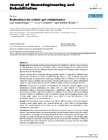Biofeedback for robotic gait rehabilitation
dc.contributor.author
Lünenburger, Lars
dc.contributor.author
Colombo, Gery
dc.contributor.author
Riener, Robert
dc.date.accessioned
2018-08-20T13:07:42Z
dc.date.available
2017-06-08T15:30:09Z
dc.date.available
2018-08-20T13:07:42Z
dc.date.issued
2007
dc.identifier.issn
1743-0003
dc.identifier.other
10.1186/1743-0003-4-1
en_US
dc.identifier.uri
http://hdl.handle.net/20.500.11850/1423
dc.identifier.doi
10.3929/ethz-b-000001423
dc.description.abstract
Background
Development and increasing acceptance of rehabilitation robots as well as advances in technology allow new forms of therapy for patients with neurological disorders. Robot-assisted gait therapy can increase the training duration and the intensity for the patients while reducing the physical strain for the therapist.
Optimal training effects during gait therapy generally depend on appropriate feedback about performance. Compared to manual treadmill therapy, there is a loss of physical interaction between therapist and patient with robotic gait retraining. Thus, it is difficult for the therapist to assess the necessary feedback and instructions. The aim of this study was to define a biofeedback system for a gait training robot and test its usability in subjects without neurological disorders.
Methods
To provide an overview of biofeedback and motivation methods applied in gait rehabilitation, previous publications and results from our own research are reviewed. A biofeedback method is presented showing how a rehabilitation robot can assess the patients' performance and deliver augmented feedback. For validation, three subjects without neurological disorders walked in a rehabilitation robot for treadmill training. Several training parameters, such as body weight support and treadmill speed, were varied to assess the robustness of the biofeedback calculation to confounding factors.
Results
The biofeedback values correlated well with the different activity levels of the subjects. Changes in body weight support and treadmill velocity had a minor effect on the biofeedback values. The synchronization of the robot and the treadmill affected the biofeedback values describing the stance phase.
Conclusion
Robot-aided assessment and feedback can extend and improve robot-aided training devices. The presented method estimates the patients' gait performance with the use of the robot's existing sensors, and displays the resulting biofeedback values to the patients and therapists. The therapists can adapt the therapy and give further instructions to the patients. The feedback might help the patients to adapt their movement patterns and to improve their motivation. While it is assumed that these novel methods also improve training efficacy, the proof will only be possible with future in-depth clinical studies.
en_US
dc.format
application/pdf
en_US
dc.language.iso
en
en_US
dc.publisher
BioMed Central
en_US
dc.rights.uri
http://creativecommons.org/licenses/by/2.0/
dc.subject
Stance Phase
en_US
dc.subject
Gait Cycle
en_US
dc.subject
Joint Torque
en_US
dc.subject
Swing Phase
en_US
dc.subject
Treadmill Training
en_US
dc.title
Biofeedback for robotic gait rehabilitation
en_US
dc.type
Journal Article
dc.rights.license
Creative Commons Attribution 2.0 Generic
ethz.journal.title
Journal of NeuroEngineering and Rehabilitation
ethz.journal.volume
4
en_US
ethz.journal.abbreviated
J. Neuroeng. Rehabilitat.
ethz.pages.start
1
en_US
ethz.size
11 p.
en_US
ethz.version.deposit
publishedVersion
en_US
ethz.publication.place
London
en_US
ethz.publication.status
published
en_US
ethz.leitzahl
ETH Zürich::00002 - ETH Zürich::00012 - Lehre und Forschung::00007 - Departemente::02070 - Dep. Gesundheitswiss. und Technologie / Dep. of Health Sciences and Technology::03654 - Riener, Robert / Riener, Robert
en_US
ethz.leitzahl.certified
ETH Zürich::00002 - ETH Zürich::00012 - Lehre und Forschung::00007 - Departemente::02070 - Dep. Gesundheitswiss. und Technologie / Dep. of Health Sciences and Technology::03654 - Riener, Robert / Riener, Robert
ethz.date.deposited
2017-06-08T15:30:24Z
ethz.source
ECIT
ethz.identifier.importid
imp59364b3ed26f695610
ethz.ecitpid
pub:11246
ethz.eth
yes
en_US
ethz.availability
Open access
en_US
ethz.rosetta.installDate
2017-07-15T09:14:30Z
ethz.rosetta.lastUpdated
2024-02-02T05:42:56Z
ethz.rosetta.versionExported
true
ethz.COinS
ctx_ver=Z39.88-2004&rft_val_fmt=info:ofi/fmt:kev:mtx:journal&rft.atitle=Biofeedback%20for%20robotic%20gait%20rehabilitation&rft.jtitle=Journal%20of%20NeuroEngineering%20and%20Rehabilitation&rft.date=2007&rft.volume=4&rft.spage=1&rft.issn=1743-0003&rft.au=L%C3%BCnenburger,%20Lars&Colombo,%20Gery&Riener,%20Robert&rft.genre=article&rft_id=info:doi/10.1186/1743-0003-4-1&
Files in this item
Publication type
-
Journal Article [128759]

